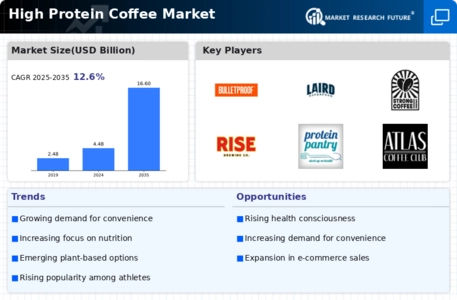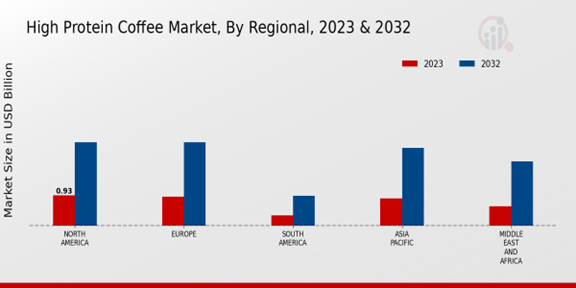E-commerce Expansion
The rise of e-commerce has transformed the Global High Protein Coffee Market Industry, enabling brands to reach a wider audience and enhance consumer accessibility. Online platforms allow for direct-to-consumer sales, which can lead to increased brand loyalty and customer engagement. Furthermore, the convenience of online shopping aligns with the fast-paced lifestyles of modern consumers. As e-commerce continues to expand, it is anticipated that the market will see accelerated growth, with projections suggesting a shift towards a more digitally-driven retail environment. This evolution may contribute to the overall market growth, reinforcing the industry's potential.
Market Growth Projections
The Global High Protein Coffee Market Industry is poised for substantial growth, with projections indicating a market size of 4.48 USD Billion in 2024 and an anticipated increase to 16.6 USD Billion by 2035. This growth trajectory suggests a robust demand for high protein coffee products, driven by evolving consumer preferences and lifestyle changes. The projected CAGR of 12.62% from 2025 to 2035 further underscores the potential for expansion within this sector. These figures reflect a dynamic market landscape, where innovation and consumer engagement will play critical roles in shaping the future of high protein coffee.
Rising Health Consciousness
The Global High Protein Coffee Market Industry is experiencing a surge in demand due to an increasing awareness of health and wellness among consumers. As individuals seek to enhance their nutritional intake, high protein coffee products are perceived as a convenient option to incorporate protein into their diets. This trend is particularly pronounced among fitness enthusiasts and those pursuing weight management. The market is projected to reach 4.48 USD Billion in 2024, reflecting a growing preference for functional beverages that offer health benefits. This shift in consumer behavior indicates a potential for sustained growth in the industry.
Innovative Product Offerings
Innovation plays a crucial role in the Global High Protein Coffee Market Industry, as brands continuously develop new flavors and formulations to attract diverse consumer segments. Companies are experimenting with various protein sources, such as whey, pea, and soy, to cater to different dietary preferences and restrictions. For instance, the introduction of ready-to-drink high protein coffee beverages has gained traction, appealing to busy consumers seeking convenient nutrition. This innovation is likely to drive market growth, with projections indicating a robust expansion towards 16.6 USD Billion by 2035, as brands strive to differentiate themselves in a competitive landscape.
Increased Investment in Marketing
Investment in marketing strategies is a pivotal driver for the Global High Protein Coffee Market Industry, as brands seek to educate consumers about the benefits of high protein coffee. Effective marketing campaigns that highlight nutritional advantages and unique selling propositions can significantly influence consumer purchasing decisions. As competition intensifies, companies are likely to allocate more resources to digital marketing, influencer partnerships, and promotional activities. This increased focus on marketing is expected to enhance brand visibility and consumer awareness, potentially leading to higher sales and market penetration in the coming years.
Growing Demand for Functional Beverages
The Global High Protein Coffee Market Industry is benefiting from a broader trend towards functional beverages, which are perceived as products that provide additional health benefits beyond basic nutrition. Consumers are increasingly seeking beverages that support energy levels, muscle recovery, and overall wellness. High protein coffee fits this demand by combining the energizing effects of coffee with the nutritional advantages of protein. This alignment with consumer preferences suggests a promising growth trajectory, with a projected CAGR of 12.62% from 2025 to 2035, indicating a significant opportunity for brands to capitalize on this trend.


















